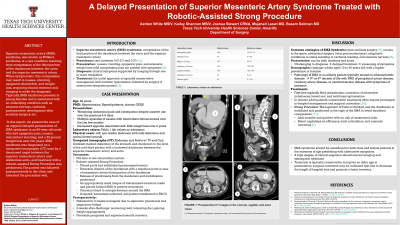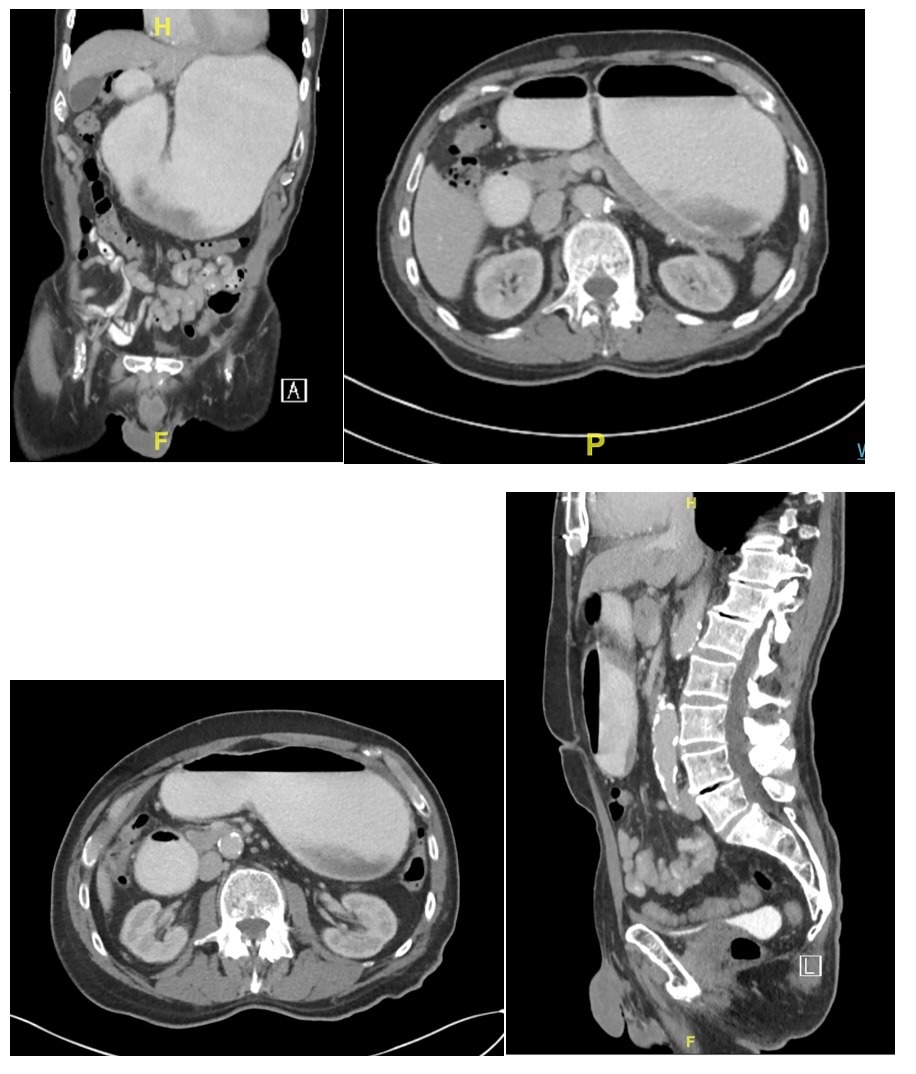Monday Poster Session
Category: Small Intestine
P3308 - A Delayed Presentation of Superior Mesenteric Artery Syndrome Treated With Robotic-Assisted Strong Procedure
Monday, October 28, 2024
10:30 AM - 4:00 PM ET
Location: Exhibit Hall E

Has Audio

Ashton White, BS
Texas Tech University Health Sciences Center School of Medicine
Amarillo, TX
Presenting Author(s)
Ashton White, BS1, Mariam Rizvi, BS2, Kailey Shannon, BS1, Mujahed Laswi, MD1, Basem Soliman, MD, PhD1
1Texas Tech University Health Sciences Center School of Medicine, Amarillo, TX; 2Texas Tech University Health Sciences Center School of Medicine, Plano, TX
Introduction: Superior mesenteric artery (SMA) syndrome is a rare, potentially life-threatening condition caused by changes in the abdominal relationship between the SMA anteriorly and the duodenum and aorta posteriorly. It typically presents in a young female and is associated with underlying conditions such as anorexia nervosa, cachexia, or postoperative development after scoliosis surgery.
We present the case of a delayed presentation SMA syndrome in an 84-year-old male to depict how it may look in an atypical demographic and demonstrate its successful management with operative treatment.
Case Description/Methods: An 84-year-old male with a past medical history of hypertension, hyperlipidemia, and chronic gastroesophageal reflux disease presented after 4-5 days of worsening abdominal pain and constipation. He described multiple episodes of nausea, intermittent bilious emesis over the past few months, and a decreased appetite associated with a 30-pound weight loss over the last 2 years. He had a calculated healthy BMI of 20.96. He denied a history of scoliosis with surgical correction, recent spinal trauma, anorexia nervosa, and had no history of cancer/neoplastic conditions.
Laboratory testing showed values within reference ranges (Table 1). A physical exam revealed a soft, non-tender abdomen with mild distention and normal bowel sounds. Computed tomography scan of the abdomen and pelvis with intravenous and oral contrast revealed marked distention of the stomach and duodenum to the level of the mid-third portion with a narrowed duodenum between the SMA and aorta, concerning for SMA syndrome (Figure 1). The patient consented for a robotic-assisted strong procedure with mobilization of the duodenum to relieve the obstruction.
The patient tolerated the procedure well without any immediate complications and remained at the hospital two weeks postoperatively under close supervision. At his appointment after discharge, our patient stated he was recovering well and tolerating his diet with no associated symptoms and gaining weight appropriately with a favorable prognosis.
Discussion: While more common in young females, SMA syndrome is a differential that should be considered in both male and female patients at the extremes of age presenting with obstructive symptoms. Varying degree of severity and onset make this syndrome difficult to diagnose, but a high degree of clinical suspicion should warrant imaging and subsequent treatment.

Note: The table for this abstract can be viewed in the ePoster Gallery section of the ACG 2024 ePoster Site or in The American Journal of Gastroenterology's abstract supplement issue, both of which will be available starting October 27, 2024.
Disclosures:
Ashton White, BS1, Mariam Rizvi, BS2, Kailey Shannon, BS1, Mujahed Laswi, MD1, Basem Soliman, MD, PhD1. P3308 - A Delayed Presentation of Superior Mesenteric Artery Syndrome Treated With Robotic-Assisted Strong Procedure, ACG 2024 Annual Scientific Meeting Abstracts. Philadelphia, PA: American College of Gastroenterology.
1Texas Tech University Health Sciences Center School of Medicine, Amarillo, TX; 2Texas Tech University Health Sciences Center School of Medicine, Plano, TX
Introduction: Superior mesenteric artery (SMA) syndrome is a rare, potentially life-threatening condition caused by changes in the abdominal relationship between the SMA anteriorly and the duodenum and aorta posteriorly. It typically presents in a young female and is associated with underlying conditions such as anorexia nervosa, cachexia, or postoperative development after scoliosis surgery.
We present the case of a delayed presentation SMA syndrome in an 84-year-old male to depict how it may look in an atypical demographic and demonstrate its successful management with operative treatment.
Case Description/Methods: An 84-year-old male with a past medical history of hypertension, hyperlipidemia, and chronic gastroesophageal reflux disease presented after 4-5 days of worsening abdominal pain and constipation. He described multiple episodes of nausea, intermittent bilious emesis over the past few months, and a decreased appetite associated with a 30-pound weight loss over the last 2 years. He had a calculated healthy BMI of 20.96. He denied a history of scoliosis with surgical correction, recent spinal trauma, anorexia nervosa, and had no history of cancer/neoplastic conditions.
Laboratory testing showed values within reference ranges (Table 1). A physical exam revealed a soft, non-tender abdomen with mild distention and normal bowel sounds. Computed tomography scan of the abdomen and pelvis with intravenous and oral contrast revealed marked distention of the stomach and duodenum to the level of the mid-third portion with a narrowed duodenum between the SMA and aorta, concerning for SMA syndrome (Figure 1). The patient consented for a robotic-assisted strong procedure with mobilization of the duodenum to relieve the obstruction.
The patient tolerated the procedure well without any immediate complications and remained at the hospital two weeks postoperatively under close supervision. At his appointment after discharge, our patient stated he was recovering well and tolerating his diet with no associated symptoms and gaining weight appropriately with a favorable prognosis.
Discussion: While more common in young females, SMA syndrome is a differential that should be considered in both male and female patients at the extremes of age presenting with obstructive symptoms. Varying degree of severity and onset make this syndrome difficult to diagnose, but a high degree of clinical suspicion should warrant imaging and subsequent treatment.

Figure: Image 1: Preoperative CT Images
Note: The table for this abstract can be viewed in the ePoster Gallery section of the ACG 2024 ePoster Site or in The American Journal of Gastroenterology's abstract supplement issue, both of which will be available starting October 27, 2024.
Disclosures:
Ashton White indicated no relevant financial relationships.
Mariam Rizvi indicated no relevant financial relationships.
Kailey Shannon indicated no relevant financial relationships.
Mujahed Laswi indicated no relevant financial relationships.
Basem Soliman indicated no relevant financial relationships.
Ashton White, BS1, Mariam Rizvi, BS2, Kailey Shannon, BS1, Mujahed Laswi, MD1, Basem Soliman, MD, PhD1. P3308 - A Delayed Presentation of Superior Mesenteric Artery Syndrome Treated With Robotic-Assisted Strong Procedure, ACG 2024 Annual Scientific Meeting Abstracts. Philadelphia, PA: American College of Gastroenterology.

